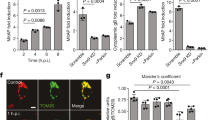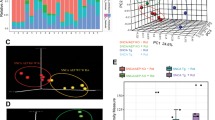Abstract
Parkinson’s disease (PD) is a neurodegenerative disorder characterized by the abnormal aggregation of α-synuclein (α-syn) and the loss of dopaminergic neurons. Although microbial infection has been implicated in the pathogenesis of PD, the associated virulence factors and the underlying molecular mechanisms require further elucidation. Here, we found that intestinal infection with Nocardia farcinica induced a series of PD-like symptoms in Caenorhabditis elegans, such as the accelerated degeneration of dopaminergic neurons, impaired locomotion capacity, and enhanced α-syn aggregation, through the disturbance of mitochondrial functions. To identify the potential virulence factors involved in these effects, we knocked out the nbtB/C and nbtS genes in N. farcinica, which are localized in the gene clusters responsible for nocobactin biosynthesis. The deletion of either gene partially rescued the degenerative effects of wild-type N. farcinica on dopaminergic neurons by attenuating mitochondrial dysfunction. LC–MS analysis further identified a decrease in the abundance of several siderophores in the two mutants, including nocobactin NA-a, nocobactin NA-b, and nocardimicin B. Collectively, our results demonstrated that intestinal N. farcinica infection in C. elegans facilitates PD-like pathogenesis and provides novel evidence for the involvement of pathogenic bacteria in neurodegenerative diseases via non-neuroinvasive mechanisms.






Similar content being viewed by others
Data Availability
No datasets were generated or analysed during the current study.
References
Poewe W, Seppi K, Tanner CM, Halliday GM, Brundin P, Volkmann J, Schrag AE, Lang AE (2017) Parkinson disease. Nat Rev Dis Primers 3:17013. https://doi.org/10.1038/nrdp.2017.13
Spillantini MG, Crowther RA, Jakes R, Hasegawa M, Goedert M (1998) alpha-Synuclein in filamentous inclusions of Lewy bodies from Parkinson’s disease and dementia with Lewy bodies. Proc Natl Acad Sci U S A 95:(11):6469-6473. https://doi.org/10.1073/pnas.95.11.6469
Peng J, Peng L, Stevenson FF, Doctrow SR, Andersen JK (2007) Iron and paraquat as synergistic environmental risk factors in sporadic Parkinson’s disease accelerate age-related neurodegeneration. J Neurosci: Off J Soc Neurosci 27(26):6914–6922. https://doi.org/10.1523/jneurosci.1569-07.2007
Kouli A, Torsney KM, Kuan WL (2018) Parkinson’s disease: etiology, neuropathology, and pathogenesis. In: Stoker TB, Greenland JC (eds) Parkinson’s disease: pathogenesis and clinical aspects. https://doi.org/10.15586/codonpublications.parkinsonsdisease.2018.ch1
Twelves D, Perkins KS, Counsell C (2003) Systematic review of incidence studies of Parkinson’s disease. Mov Disord 18(1):19–31. https://doi.org/10.1002/mds.10305
Patrick KL, Bell SL, Weindel CG, Watson RO (2019) Exploring the “multiple-hit hypothesis” of neurodegenerative disease: bacterial infection comes up to bat. Front Cell Infect Microbiol 9:138. https://doi.org/10.3389/fcimb.2019.00138
Shen CH, Chou CH, Liu FC, Lin TY, Huang WY, Wang YC, Kao CH (2016) Association between tuberculosis and Parkinson disease: a nationwide, population-based cohort study. Medicine (Baltimore) 95(8):e2883. https://doi.org/10.1097/MD.0000000000002883
Wang H, Liu X, Tan C, Zhou W, Jiang J, Peng W, Zhou X, Mo L, et al. (2020) Bacterial, viral, and fungal infection‐related risk of Parkinson’s disease: meta‐analysis of cohort and case–control studies. Brain Behavior 10(3). https://doi.org/10.1002/brb3.1549
Kaur T, Uppoor A, Naik D (2015) Parkinson’s disease and periodontitis – the missing link? A review. Gerodontology 33(4):434–438. https://doi.org/10.1111/ger.12188
Choi JG, Kim N, Ju IG, Eo H, Lim SM, Jang SE, Kim DH, Oh MS (2018) Oral administration of Proteus mirabilis damages dopaminergic neurons and motor functions in mice. Sci Rep 8(1):1275. https://doi.org/10.1038/s41598-018-19646-x
Kohbata S, Beaman BL (1991) L-dopa-responsive movement disorder caused by Nocardia asteroides localized in the brains of mice. Infect Immun 59(1):181–191. https://doi.org/10.1128/iai.59.1.181-191.1991
Tam S, Barry DP, Beaman L, Beaman BL (2002) Neuroinvasive Nocardia asteroides GUH-2 induces apoptosis in the substantia nigra in vivo and dopaminergic cells in vitro. Exp Neurol 177(2):453–460. https://doi.org/10.1006/exnr.2002.8012
Matheoud D, Cannon T, Voisin A, Penttinen AM, Ramet L, Fahmy AM, Ducrot C, Laplante A et al (2019) Intestinal infection triggers Parkinson’s disease-like symptoms in Pink1(-/-) mice. Nature 571(7766):565–569. https://doi.org/10.1038/s41586-019-1405-y
Kim J, Kang M, Kim J, Jung S, Park J, Lee D, Yoon H (2016) A Case of Nocardia farcinica pneumonia and mediastinitis in an immunocompetent patient. Tuberc Respir Dis (Seoul) 79(2):101–103. https://doi.org/10.4046/trd.2016.79.2.101
Yang R, Kang Y, Duan J, Zou C, Wu Q (2022) The p38 MAPK/PMK-1 pathway is required for resistance to nocardia farcinica infection in Caenorhabditis elegance. Pathogens 11(10). https://doi.org/10.3390/pathogens11101071
Bernardin Souibgui C, Zoropogui A, Voisin J, Ribun S, Vasselon V, Pujic P, Rodriguez-Nava V, Belly P et al (2017) Virulence test using nematodes to prescreen Nocardia species capable of inducing neurodegeneration and behavioral disorders. PeerJ 5:e3823. https://doi.org/10.7717/peerj.3823
Zhu M, Gu H, Bai H, Li Y, Zhong C, Huang X (2024) Role and molecular regulatory mechanisms of Hippo signaling pathway in Caenorhabditis elegans and mammalian cell models of Alzheimer’s disease. Neurobiol Aging 134:9–20. https://doi.org/10.1016/j.neurobiolaging.2023.09.015
Masoudi N, Ibanez-Cruceyra P, Offenburger SL, Holmes A, Gartner A (2014) Tetraspanin (TSP-17) protects dopaminergic neurons against 6-OHDA-induced neurodegeneration in C. elegans. PLoS Genet 10(12):e1004767. https://doi.org/10.1371/journal.pgen.1004767
Sawin ER, Ranganathan R, Horvitz HR (2000) C. elegans locomotory rate is modulated by the environment through a dopaminergic pathway and by experience through a serotonergic pathway. Neuron 26(3):619–631. https://doi.org/10.1016/s0896-6273(00)81199-x
Baba M, Nakajo S, Tu PH, Tomita T, Nakaya K, Lee VM, Trojanowski JQ, Iwatsubo T (1998) Aggregation of alpha-synuclein in Lewy bodies of sporadic Parkinson’s disease and dementia with Lewy bodies. Am J Pathol 152(4):879–884
Hoshino Y, Chiba K, Ishino K, Fukai T, Igarashi Y, Yazawa K, Mikami Y, Ishikawa J (2011) Identification of nocobactin NA biosynthetic gene clusters in Nocardia farcinica. J Bacteriol 193(2):441–448. https://doi.org/10.1128/JB.00897-10
Ikeda Y, Nonaka H, Furumai T, Onaka H, Igarashi Y (2005) Nocardimicins A, B, C, D, E, and F, siderophores with muscarinic M3 receptor inhibiting activity from Nocardia sp. TP-A0674. J Nat Prod 68(7):1061–1065. https://doi.org/10.1021/np050091j
Park JS, Davis RL, Sue CM (2018) Mitochondrial dysfunction in Parkinson’s disease: new mechanistic insights and therapeutic perspectives. Curr Neurol Neurosci Rep 18(5):21. https://doi.org/10.1007/s11910-018-0829-3
Chan DC (2006) Mitochondria: dynamic organelles in disease, aging, and development. Cell 125(7):1241–1252. https://doi.org/10.1016/j.cell.2006.06.010
Pickrell AM, Huang CH, Kennedy SR, Ordureau A, Sideris DP, Hoekstra JG, Harper JW, Youle RJ (2015) Endogenous parkin preserves dopaminergic substantia nigral neurons following mitochondrial DNA mutagenic stress. Neuron 87(2):371–381. https://doi.org/10.1016/j.neuron.2015.06.034
Chakraborty S, Bornhorst J, Nguyen TT, Aschner M (2013) Oxidative stress mechanisms underlying Parkinson’s disease-associated neurodegeneration in C. elegans. Int J Mol Sci 14(11):23103–23128. https://doi.org/10.3390/ijms141123103
Yang W, Hekimi S (2010) A mitochondrial superoxide signal triggers increased longevity in Caenorhabditis elegans. PLoS Biol 8(12):e1000556. https://doi.org/10.1371/journal.pbio.1000556
Hawkes CH, Del Tredici K, Braak H (2007) Parkinson’s disease: a dual-hit hypothesis. Neuropathol Appl Neurobiol 33(6):599–614. https://doi.org/10.1111/j.1365-2990.2007.00874.x
Rietdijk CD, Perez-Pardo P, Garssen J, van Wezel RJ, Kraneveld AD (2017) Exploring Braak’s hypothesis of Parkinson’s disease. Front Neurol 8:37. https://doi.org/10.3389/fneur.2017.00037
Pont-Sunyer C, Hotter A, Gaig C, Seppi K, Compta Y, Katzenschlager R, Mas N, Hofeneder D et al (2015) The onset of nonmotor symptoms in Parkinson’s disease (the ONSET PD study). Mov Disord 30(2):229–237. https://doi.org/10.1002/mds.26077
Holmqvist S, Chutna O, Bousset L, Aldrin-Kirk P, Li W, Björklund T, Wang ZY, Roybon L et al (2014) Direct evidence of Parkinson pathology spread from the gastrointestinal tract to the brain in rats. Acta Neuropathol 128(6):805–820. https://doi.org/10.1007/s00401-014-1343-6
Svensson E, Horváth-Puhó E, Thomsen RW, Djurhuus JC, Pedersen L, Borghammer P, Sørensen HT (2015) Vagotomy and subsequent risk of Parkinson’s disease. Ann Neurol 78(4):522–529. https://doi.org/10.1002/ana.24448
Ji X, Han L, Zhang W, Sun L, Xu S, Qiu X, Fan S, Li Z (2022) Molecular, cellular and neurological consequences of infection by the neglected human pathogen Nocardia. BMC Biol 20(1):251. https://doi.org/10.1186/s12915-022-01452-7
Palmer LD, Skaar EP (2016) Transition metals and virulence in bacteria. Annu Rev Genet 50:67–91. https://doi.org/10.1146/annurev-genet-120215-035146
Iruretagoyena MI, Tobar JA, González PA, Sepúlveda SE, Figueroa CA, Burgos RA, Hancke JL, Kalergis AM (2005) Andrographolide interferes with T cell activation and reduces experimental autoimmune encephalomyelitis in the mouse. J Pharmacol Exp Ther 312(1):366–372. https://doi.org/10.1124/jpet.104.072512
Yan J, Zhao N, Yang Z, Li Y, Bai H, Zou W, Zhang K, Huang X (2020) A trade-off switch of two immunological memories in Caenorhabditis elegans reinfected by bacterial pathogens. J Biol Chem 295(50):17323–17336. https://doi.org/10.1074/jbc.RA120.013923
Dan Dunn J, Alvarez LAJ, Zhang X, Soldati T (2015) Reactive oxygen species and mitochondria: a nexus of cellular homeostasis. Redox Biol 6:472–485. https://doi.org/10.1016/j.redox.2015.09.005
Cardoso SM, Empadinhas N (2018) The microbiome-mitochondria dance in prodromal Parkinson’s disease. Front Physiol 9:471. https://doi.org/10.3389/fphys.2018.00471
Santos D, Esteves AR, Silva DF, Januário C, Cardoso SM (2015) The impact of mitochondrial fusion and fission modulation in sporadic Parkinson’s disease. Mol Neurobiol 52(1):573–586. https://doi.org/10.1007/s12035-014-8893-4
Brookes PS, Yoon Y, Robotham JL, Anders MW, Sheu SS (2004) Calcium, ATP, and ROS: a mitochondrial love-hate triangle. Am J Physiol Cell Physiol 287(4):C817-833. https://doi.org/10.1152/ajpcell.00139.2004
Mir DA, Balamurugan K (2019) A proteomic analysis of Caenorhabditis elegans mitochondria during bacterial infection. Mitochondrion 48:37–50. https://doi.org/10.1016/j.mito.2019.03.002
Acknowledgements
The authors thank all the participants of the present study.
Funding
This work was supported by the National Natural Science Foundation Program of China (grant no. 32170184), the Department of Science and Technology of Yunnan Province (202403AC100007), and the Yunnan University Graduate Research Innovation Fund (KC-22221700).
Author information
Authors and Affiliations
Contributions
All authors contributed to the study conception and design. Xiaowei Huang and Ninghui Zhao designed and supervised the entire process of the experiment and were the co-correspondent authors. Wenwen Liu, Wenhui Zhou and Peiji Zhao, co-first authors, carried out experiments with Tingting Wu, Huan Gu, and Yixin Li. Analysis of LC-MS data was conducted by Peiji Zhao. Statistical analysis was conducted by Chidi Zhong and Hua Bai. Wenwen Liu, Wenhui Zhou and Xiaowei Huang provided technical assistance reviewed and edited the manuscript. All authors reviewed the manuscript.
Corresponding authors
Ethics declarations
Ethics Approval
Not applicable to this study.
Consent to Participate
Not applicable to this study.
Consent for Publication
Not applicable to this study.
Competing Interests
The authors declare no competing interests.
Additional information
Publisher's Note
Springer Nature remains neutral with regard to jurisdictional claims in published maps and institutional affiliations.
Supplementary Information
Below is the link to the electronic supplementary material.
Rights and permissions
Springer Nature or its licensor (e.g. a society or other partner) holds exclusive rights to this article under a publishing agreement with the author(s) or other rightsholder(s); author self-archiving of the accepted manuscript version of this article is solely governed by the terms of such publishing agreement and applicable law.
About this article
Cite this article
Liu, W., Zhou, W., Zhao, P. et al. PD-Like Pathogenesis in Caenorhabditis elegans Intestinally Infected with Nocardia farcinica and the Underlying Molecular Mechanisms. Mol Neurobiol (2024). https://doi.org/10.1007/s12035-024-04076-w
Received:
Accepted:
Published:
DOI: https://doi.org/10.1007/s12035-024-04076-w




